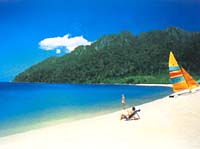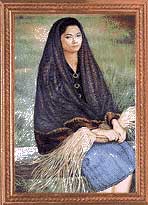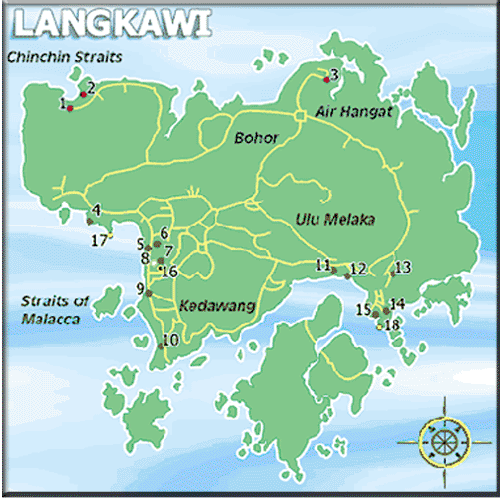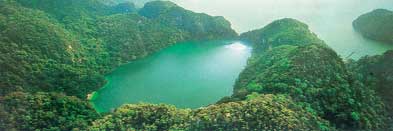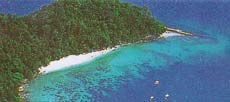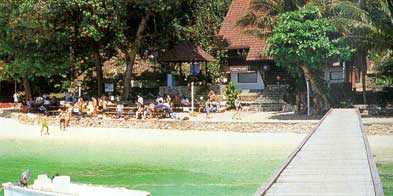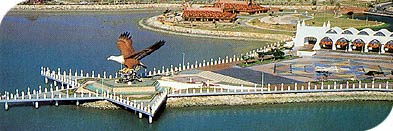|
|
|
|
The isles of Langkawi - ninety nine of them, are tucked into the northwest corner of the peninsula and nestled on the Thai-Malaysian sea border. Unspoilt and rustic, it is a tropical paradise spectacularly endowed by nature, one where crystal clear emerald waters, azure skies, lush green vegetation and fantastic limestone formations can be found. Populated by approximately 40,000 inhabitants, mostly Malays, it offers myriad possibilities for both the weary and the adventurous and is nothing short of a “must” for the avid and fun-loving traveller. |
|
But Langkawi is more than captivating beauty... it is also a land steep in legends and shrouded in mystery. The best known legend is of Mashuri, a pretty maiden who lived some 200 years ago. Executed for a crime she did not commit, she laid a curse on the land, that "...Langkawi shall not prosper for seven generations to come." Seven generations of barren underdevelopment have passed. As the cloud of both social and economic gloom passes, Langkawi is poised to take its place as a premier holiday venue.
|
|
|
|
|
1. The Andaman Datai |
|
|
|
Pulau Tuba If you make it a point to visit Langkawi when it has fine weather,
then you could take one or several trips to the nearby islands, starting with
Pulau Tuba, about five kilometres south of Langkawi island. It is the only
other island that offers accommodation to tourists but it is a case of 'take
it or leave it' as there is only one place to stay. Sunrise Beach Resort has
its own swimming pool but if you're the type of tourist who prefers the
backpacking style of travelling and accommodation, then you'll probably have
to head back to Langkawi for the night. |
|
Pulau Dayang Bunting Next on the itinerary
is Pulau Dayang Bunting, or the Isle of the Pregnant Maiden. With no
accommodation facilities available, this stop will have to be a day trip. A mere
fifteen minutes' boat ride from Langkawi, it is the second largest island in
the archipelago. There are two places of interest here, namely, the Gua
Langsir (Cave of the Banshee) and Tasik Dayang Bunting (Lake of the Pregnant
Maiden). Marble is also quarried here and sent by ship to the mainland for
processing. Bunting Tasik Dayang Bunting is the
freshwater lake the island is named for. It is a large lake, with tranquil
surroundings and is suitable for swimming. Its waters are also said to
possess magical powers that will enable barren women to bear children if they
drink water from the lake. |
|
|
|
|
|
Pulau Singa Besar Nature-lovers
must not miss Pulau Singa Besar, which is a wildlife sanctuary located three
kilometres off the southern tip of Pantai Tengah on the west coast of
Langkawi. It is a designated stop for the island-hopping boat. |
|
Pulau Bumbon Ten minutes from the Kuah jetty lies yet another island, Pulau Bumbon. There are some pleasant beaches there and you can get to Pulau Bumbon by booking yourself a day trip at the price RM 25. A pleasant enough place to spend a few hours of peace and quiet on a deserted island. |
|
|
|
|
|
Pulau Payar Marine Park About thirty kilometres south of
Pulau Langkawi lies a group of islands known as the Pulau Payar Marine Park.
This marine park is named after Pulau Payar, the biggest island of the group.
A haven for divers, there are beautiful coral reefs and many schools of
tropical fish. Divers will inevitably be drawn to the coral garden, about
thirteen kilometres away from the peninsula as it has the most species of
coral in the country. What's more, they get to enjoy the sight of colourful fishes
darting playfully in and out of the corals. Revel in the company of shoals
and shoals of fishes as they go about their busy way. Various seashells,
shellfishes and slugs that are scattered all over the seabed complete the
wonderful underwater vista. There is a sense of calm amidst the hustle and
bustle of life in the water. The tranquil surface belies the teeming life
below. |
|
Kuah Kuah is the main town and visitors head here to do the bulk of their shopping, despite it being rather small. Located on the south-eastern part of the island, Kuah was once a fishing village but has now caught up with time and commerce is ever present. At the centre of town, visitors can find banks, duty-free shops, small emporiums, spanking new luxury hotels as well as large shopping malls. In fact, the banks here are probably the only places on Langkawi to change your currency (ringgit being the Malay currency). Although this is a seaside community, Kuah has no beach as such, however still features a number of interesting places to visit.One of Kuah's newest attractions is the Dataran Lang - for helang - or Eagle Square, where a huge sculpture of an eagle sits and presides over the island after which it is named. Situated just beside the ferry terminal, it is probably the first sight that greets visitors as they alight from boats or ferries. |
|
|
|
|
|
|
|
Other interesting websites about Langkawi: |

.gif)
